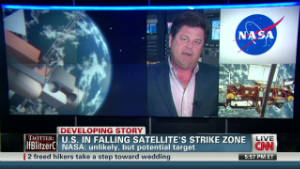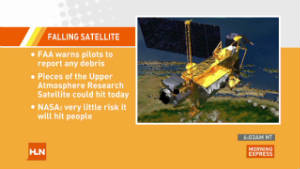September 24, 2011 -- Updated 1303 GMT (2103 HKT)
STORY HIGHLIGHTS
- NEW: NASA: The satellite penetrated through the atmosphere over the Pacific Ocean
- A man in Hawaii says he thinks he saw pieces fall from the sky
- About 26 pieces, some weighing hundreds of pounds, were expected to survive re-entry
- It is not clear exactly where the pieces might have landed
The space agency said the Upper Atmosphere Research Satellite "is down," according to the space agency's Twitter page. NASA said debris fell to Earth between 11:23 p.m. ET Friday and 1:09 a.m. ET Saturday, but it was not immediately clear where the pieces may have landed.
NASA said the satellite pierced through the atmosphere over the Pacific Ocean, but the exact time and location were not known.
About two dozen pieces of the satellite were expected to survive the crash through the Earth's atmosphere.
Late Friday night, NASA predicted satellite parts would pass "over Canada and Africa, as well as vast areas of the Pacific, Atlantic and Indian oceans."
 U.S. in falling satellite's strike zone
U.S. in falling satellite's strike zone
 FAA: Pilots watch for falling satellite
FAA: Pilots watch for falling satellite
The 26 pieces expected to survive the descent -- made of stainless steel, titanium and beryllium that won't burn -- ranged from about 10 pounds to hundreds of pounds, according to NASA.
"The U.S. is very safe from (the satellite) ... It's final orbit did not cross the United States," the space agency tweeted early Saturday.
But reports of suspected sightings emerged from San Antonio, Texas, where a TV photographer caught images of bright objects darting rapidly in the night sky, and from Hawaii, where Robert Jeffcoat saw what he believed were two chunks from the satellite.
Jeffcoat was running errands when the first flying object left a thick, white trail that lingered in the sky for about 20 minutes, he said. A second object followed the same path and was "massive," he said.
"It's was like a comet, but smoke," he said. "I'm guessing it landed in the ocean, the way it was going."
Mark Matney of NASA's Orbital Debris team in Houston said before spacial rubbish fell that there was no way to know exactly where the pieces would come down.
"Part of the problem is, the spacecraft is tumbling in unpredictable ways, and it is very difficult to very precisely pinpoint where it's coming down even right before the re-entry," Matney said.
The Federal Aviation Administration released an advisory Thursday warning pilots about the falling satellite, calling it a potential hazard.
"It is critical that all pilots/flight crew members report any observed falling space debris to the appropriate (air traffic control) facility and include position, altitude, time and direction of debris observed," the FAA statement said.
The FAA said warnings of this sort typically are sent out to pilots concerning specific hazards they may encounter during flights such as air shows, rocket launches, kites and inoperable radio navigational aids.
NASA said space debris the size of the satellite's components re-enters the atmosphere about once a year. Harvard University astrophysicist Jonathan McDowell noted that the satellite is far from being the biggest space junk to come back.
"This is nothing like the old Skylab scare of the '70s, when you had a 70-ton space station crashing out of the sky," McDowell said.
Pieces of Skylab came down in western Australia in 1979.
Jeffcoat said he was amazed his home of Paia, Maui, seemed to be an ideal place to watch hunks of a satellite rain from the sky.
"Off all the places in the world where it could hit, here it was, in Maui," he said. "It was quite weird."
CNN's John Zarella, Holly Yan and Mike Ahlers contributed to this report.

![Validate my Atom 1.0 feed [Valid Atom 1.0]](valid-atom.png)























































